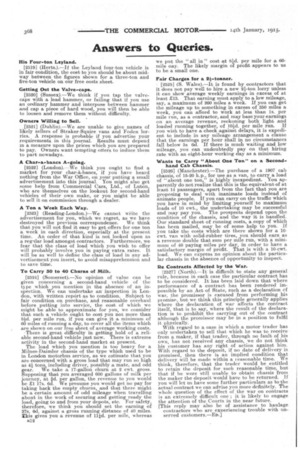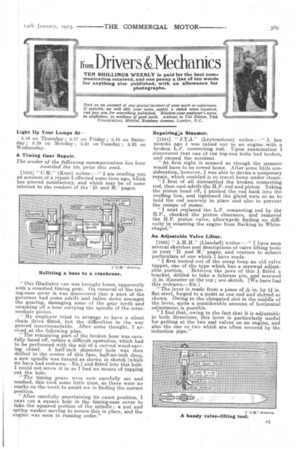Answers to Queries.
Page 18

Page 19

If you've noticed an error in this article please click here to report it so we can fix it.
His Four-ton Leyland.
[2519] (Herts.).—If the Leyland four-ten vehicle is in fair condition, the cost to you should be about midway between the figures shown for a three-ton and five-ton vehicle on our free costs sheet.
Getting Out the Valve-caps.
[2529] (Sussex).—We think if you tap the valvecaps with a lead hammer, or failing that if you use an ordinary hammer and interpose between hammer and cap a piece of hard wood, you will then be able to loosen and remove them without difficulty.
Owners Willing to Sell.
[2521] (Dublin).—We are unable to give names of likely sellers of Straker -Squire vans and Foden lorries. A response is probable if you advertise your requirements in this journal. Results must depend in a measure upon the prices which you are prepared to pay. Owners want tempting otters to induce them to part nowadays.
A Char-a-bancs A-going.
[2522] (London).—We think you ought to find a market for your char-a-bancs, if you have heard nothing from the War Office, on your putting a small advertisement into this journal. You might also get some help from Commercial Cars, Ltd., of Luton, who are themselves on the lookout for second-hand vehicles of their own make, or you might be able to sell it on commission through a dealer.
A Ton a Week Each Way.
12523] (Reading-London.)--We cannot write the advertisement for you, which we regret, as we have destroyed the previous correspondenae. We think that you will not find it easy to get offers for one ton a week in each direction, especially at the present time. An order of that kind is not looked upon as a negalar load amongst contractors. Furthermore we fear that the class of load which you -wish to Offer will probably involve you in paying extra rates. It will be as well to define the class of load in any advertisement you insert, to avoid misapprehension and to save time.
To Carry 50 to 40 Churns of Milk.
[2524] (Somerset).—No opinion of value can be given concerning a second-hand vehicle of the tjpe which you mention in the absence of an inspection. We can undertake an inspection in London, with written report as to condition. Subject to fair condition on purchase, and reasonable overhaul before putting into service, the cost of whichwe might be able to approximate for you, we consider that such a vehicle ought to cost you not more than 80. per mile run, if you can give it a minimum of 60 miles of running a day, to cover all the items which are shown on our free sheet of average working costa. -There is great difficulty in getting hold of a reliable second-hand vehicle just now. There is extreme activity in the second-hand market at present.
The load which you mention is too heavy for a Milnes-Daimler chassis of the type which used to be in London motorbus service, as we estimate that you are concerned with a gross load that may run so high as 41. tons, including driver, possibly a mate, and odd gear. We take a 17-gallon churn at 2 cwt. gross. Supposing that you averaged 600 gallons of milk per journey, at id. per gallon, the revenue to you would be El 17s. 6d. We presume you would get no pay for taking back the empty churns, and that there might be a certain amount of odd mileage when travelling about in the work of securing and getting ready the load, going to and from your depots, etc. For safety, therefore, we think you should set the earning of 37s. 6d. against a gross running distance of 40 miles. This gives you a revenue of Did. per mile, whereas al2 we put the "all in" cost at 81d. per mile for a 60mile oay. The likely margin of profit appears to us to be a small one.
Fair Charges for a 2A-tonner.
• [2525] (S_ Wales).—It is found by contractors that it does not pay well to hire a, new 2k-ton lorry unless it can show average weekly earnings in excess of at least E13. That earning must apply to a low mileage, say, a. maximum of 260 miles a week. If you can get the mileage up to something in excess of 350 miles a week, you can afford to work at less than is. per mile run, as a contractor, and may base your earnings on an average revenue, reckoning both light and loaded running together, of 100. per mile run. If you wish to have a check against delays, it is expedient to include in any mileage arra.,ngement a clause that the earnings per hour shall in no circumstances fall below Sc 6d. If there is much waiting and low mileage, you can undoubtedly pay on that hiring rate with an eight-hour working day as a minimum.
Wants to Carry "About One Ton" on a Secondhand Cab Chassis.
[2526] (Manchester).—The purchase of a 1907 cab chassis of 15-20 h.p., for use as a van, to carry a load of "about one ton," is highly inexpedient. You apparently do not realize that this is the equivalent of at least 14 passengers, apart from the fact that you are proposing to deal with inanimate loads instead of animate people. If you can carry on the traffic which you have in mind by limiting yourself to maximum loads of 10 cwt., the undertaking may be successful and may pay you. The prospects depend upon the condition of the chassis, and the way it is handled. Our standard sheet of running costs, a copy of which has been mailed, may be of some help to you. If you take the costs which are there shown for a 10cwt. van with solid-rubber tires, _von should earn as a revenue double that sum per mile run, with a minimum of 40 paying miles per day, in order to have a satisfactory margin of profit. That is with a 10-cwt. load. We can express no opinion about the particular chassis in the absence of opportunity to inspect..
Re Contracts Affected by the War.
[2527] (North).—It is difficult to state any general rule, because in each case the particular contract has to be considered. It has been laid down that where performance of a contract has been rendered impossible by an Act of State, such as a declaration of war, the promissor is excused from performing his promise, but we think this principle generally applies where the declaration of war affects the contract itself, that is to say, where the result of the declaration is to prohibit the carrying out of the contract although the promissor may be in a oosition to fulfil it physically. With regard to a case in which a motor trader has only undertaken to sell that which he was to receive from a maker, if that trader, through no fault of his own, has not received any aassis, we do not think his customer has any right of action against him. With regard to the deposit, if no data of delivery is promised, then there Is an implied condition that delivery will be made within a ieasona,ble time. We think, therefore, that the trader would be entitled to retain the deposit for such reasonable time, but that if he were still unable to obtain chassis from the maker the deposit would have to be returned. If you will let us have some further particulars as to the actual contract we can advise you more definitely. The whole question of the effect of the war on contracts is an. extremely difficult one ; it is likely to engage the attention of the Courts in the near future.
[This reply may also be of assistance to haulage contractors who are experiencing trouble with unserved customers.—En.] Light Up Your Lamps At 5.16 on Thursday ; 5.17 on Friday ; 5.18 on Saturday; 5.19 on Monday ; 5.21 on Tuesday ; 5.23 on Wednesday.
A Timing Gear Repair.
The sender of the following communication has been awarded the I0s, prize this week.
[1583] " C.1VI." (Kent) writes :—" I am sending you an account of .a repair I effected some time ago, which has proved satisfactory, and which may be of some interest to the readers of the '1). and M.' pages.
" Our Gladiator van was brought home, apparently with a smashed timing gear. On removal of the timing-case cover it was discovered that a part of the governor had come adrift and fallen down amongst the gearing, damaging some of the gear teeth and smashing off a boss carrying the spindle of the intermediate pinion. " My employer tried to arrange to have a silent chain drive fitted, but the difficulties in the way proved insurmountable. After some thought, I arrived at the following Plan. " The remaining part of the broken boss was carefully faced off, rather a difficult operation, which had to be performed with the aid of a curved wood-carving chisel. A half-inch diameter hole was then drilled in the centre of this face, half-an-inch deep, a new spindle was turned as shown in sketch [which we have had redrawn.—in.] and fitted into this hole. I could not screw it in as I had no means of tapping out the hole.
"The timing gears were now carefully set and meshed, this took some little time, as there were no marks on the teeth to assist me in finding the correct position.
" After carefully ascertaining its exact position, I next cut a square hole in the timing-case cover to take the squared portion of the spindle ; a nut and spring washer. serving to secure this in place, and the engine was soon in running order." Repairing:a Steamer.
[1584] " J.T.A." (Leytonstone) writes :—" A few months ago 1 was called out to an engine with a broken L.1). connecting rod. Upon examination I discovered that one of the big-end bolts had broken, and caused the accident.
" At first sight it seemed as though the steamer would have to be towed home. After some little consideration, however, I was able to devise a temporary repair, which enabled it to travel home under steam.
' I first of all dismantled the broken connecting rod, then cast adrift the H.P. rod and piston. Taking the piston head off, I pushed the rod back into the stuffing box and tightened the gland nuts so as to• hold the rati securely in place and also to prevent the escape of steam.
"I next replaced the L.P. connecting rod by the H.P. checked the piston clearance, and removed
the 11.P. piston valve, afterwards finding no difficulty in steaming the engine from Barking to Whitechapel."
An Adjustable Valve Lifter.
[1585] " A. H. " (Llandaff) writes :—" I have seen several sketches and descriptions of valve lifting tools in your D. and M.' • pages, and venture to submit particulars of one which 1 have made.
"I first rooted out of the scrap heap an old valve tappet, one of the type which has a screwed adjustable portion. Between the jaws of this I fitted a bracket, drilled to take a fulcrum pin, and screwed 4 in. diameter on the top ; see sketch. [We have had this redrawn.—ED.l "The lever is made from a piece of i1r in. by if in. flat steel, forged to a point at one end and slotted as shown. Owing to the elongated slot in the middle of the lever, quite a, considerable amount of horizontal adjustment is possible. I find that, owing to the fact that it is adjustable in both directions, this lever is particularly useful for getting at the two end valves on an engine, and also the one or two which are often covered by the induction pipe."




















